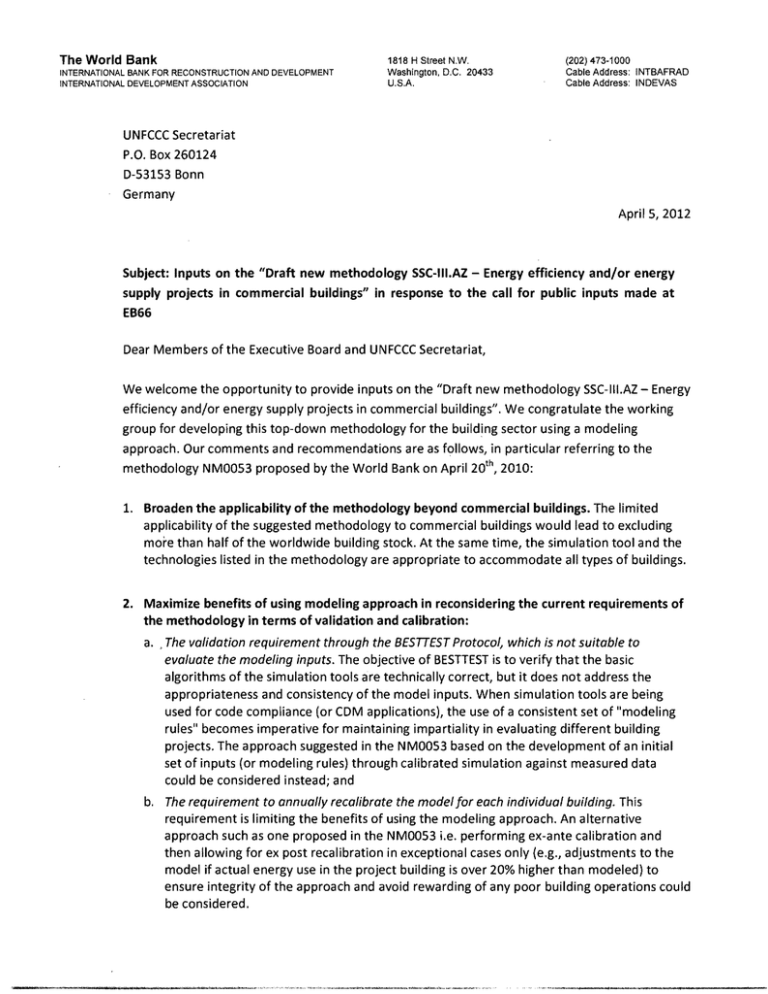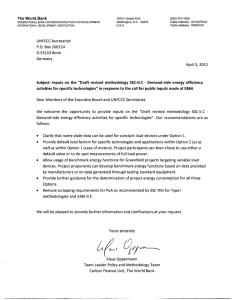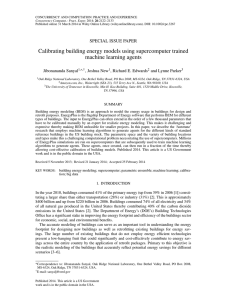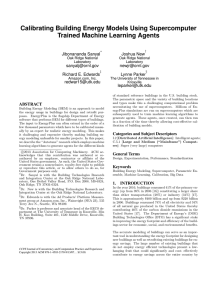The World Bank
advertisement

The World Bank INTERNATIONAL BANK FOR RECONSTRUCTION AND DEVELOPMENT INTERNATIONAL DEVELOPMENT ASSOCIATION 1818 H Street N.w. Washington, D.C. 20433 U.S.A. (202) 473·1000 Cable Address: INTBAFRAD Cable Address: INDEVAS UNFCCC Secretariat P.O. Box 260124 0-53153 Bonn Germany April 5, 2012 Subject: Inputs on the "Draft new methodology sse-III.AZ - Energy efficiency and/or energy supply projects in commercial buildings" in response to the call for public inputs made at EB66 Dear Members of the Executive Board and UNFCCC Secretariat, We welcome the opportunity to provide inputs on the "Draft new methodology SSC-III.AZ - Energy efficiency and/or energy supply projects in commercial buildings". We congratulate the working group for developing this top-down methodology for the building sector using a modeling approach. Our comments and recommendations are as follows, in particular referring to the methodology NM0053 proposed by the World Bank on April 20 th , 2010: 1. Broaden the applicability of the methodology beyond commercial buildings. The limited applicability of the suggested methodology to commercial buildings would lead to excluding more than half of the worldwide building stock. At the same time, the simulation tool and the technologies listed in the methodology are appropriate to accommodate all types of buildings. 2. Maximize benefits of using modeling approach in reconsidering the current requirements of the methodology in terms of validation and calibration: a..The validation requirement through the BESTTEST Protocol, which is not suitable to evaluate the modeling inputs. The objective of BESTTEST is to verify that the basic algorithms of the simulation tools are technically correct, but it does not address the appropriateness and consistency of the model inputs. When simulation tools are being used for code compliance (or COM applications), the use of a consistent set of "modeling rules" becomes imperative for maintaining impartiality in evaluating different building projects. The approach suggested in the NM0053 based on the development of an initial set of inputs (or modeling rules) through calibrated simulation against measured data could be considered instead; and b, The requirement to annually recalibrate the modelfor each individuol building. This requirement is limiting the benefits of using the modeling approach. An alternative approach such as one proposed in the NM0053 i.e. performing ex-ante calibration and then allowing for ex post recalibration in exceptional cases only (e.g., adjustments to the model if actual energy use in the project building is over 20% higher than modeled) to ensure integrity of the approach and avoid rewarding of any poor building operations could be considered. The World Bank INTERNATIONAL BANK FOR RECONSTRUCTION AND DEVELOPMENT INTERNATIONAL DEVELOPMENT ASSOCIATION 1818 H Street NW. . Washington, D.C. 20433 U.S.A. (202) 473-1000 Cable Address: INTBAFRAD Cable Address: INDEVAS c. Calibration requirement for the baseline setting for existing buildings. In the new methodology SSe-III.AZ, the calibration approach is established only ex-post which is not properly addressing the needs of baseline setting for retrofits. In this regard, we would recommend to clarify that the same tool as in the project scenario can be used and needs to be calibrated ex-ante based on historical energy consumption data. 3. Reconsider the principle of baseline determination for new buildings based on minimum energy requirements in the building code. In practice, building energy codes do not usually define energy requirements (budgets) as predictors of actual energy use. We are not aware of any country where the building energy standards are used to mandate the energy performance of a building. Even when codes define energy budgets, these hypothetical numbers are used only for determining whether a building meets the code, and frequently do not match actual building energy use. In this regard, we would recommend the sse WG to further consider this requirement of the methodology from both practical and technical paints of view. We will be pleased to provide further information and clarifications at your request. Yours sincerely ?f-r 'I q~6_""'" Klaus Oppermann Team Leader Policy and Methodology Team Carbon Finance Unit, The World Bank









